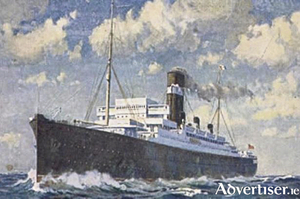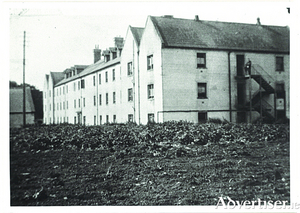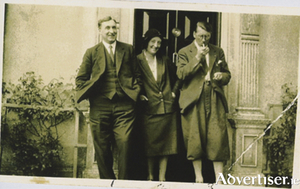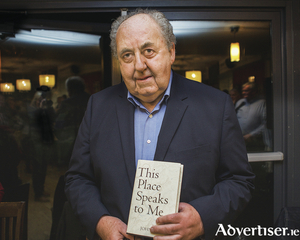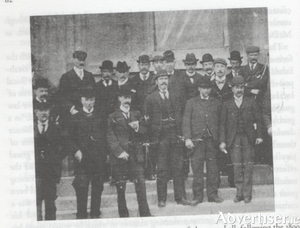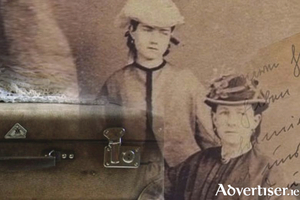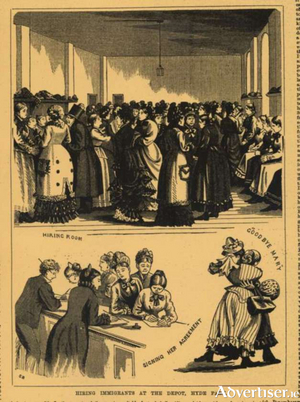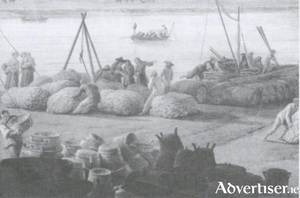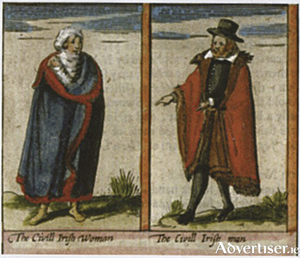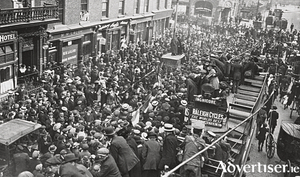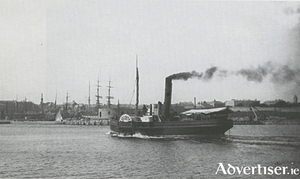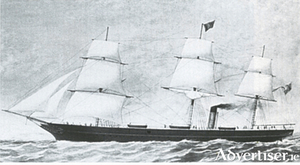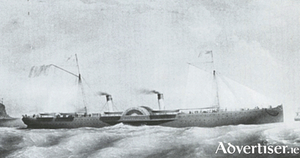Galway was ready to receive SS Athenia survivors
Thu, Feb 09, 2017
In the early afternoon of Monday September 4 1939, Galway’s harbour master, Captain Tom Tierney, was amazed to be contacted by radio from a Norwegian freighter Knute Nelson. It was steaming south towards Galway with 430 survivors from the passenger liner SS Athenia, which had been torpedoed 250 miles north-west of Inishtrahull Island, off the Donegal coast. Many of the survivors needed medical attention. Was Galway in a position to offer aid and safety?
Read more ...The knights ride to the rescue
Thu, Feb 02, 2017
I have written before about the woeful lack of ambulances that serviced the old Central Hospital, especially in the 1930s. That shortage became acute during the war. Because of the severe rationing of petrol, and the unavailability of spare parts, for a long period only two ambulances were available for the whole county. As they were frequently on the road simultaneously there was no reserve vehicle to answer any emergency.
That crisis was relieved somewhat by the founding of the Knights of Malta Ambulance Corps. The Galway unit was the first to be established in Ireland. It was set up by Professor Conor O’Malley in October 1937, and the following year the unit had passed all its medical training. It was now ready to be fitted with its distinctive grey uniform, peaked cap or beret, with its white cross against a red shield badge. Its first public appearance was the Corpus Christi procession in 1939. It was the first time in Ireland a unit of Knights of Malta appeared, and it was regarded with great curiousity. Rather shyly the young volunteers lined up outside the Nurses’ Home, before marching through the town. But they were quickly put to good use attending the sick at Knock and covering GAA matches. During the war, until the Irish Red Cross was formed, it manned first-aid stations at the university and Woodquay. It provided a transport service for the sick, and provided home nursing. It transported TB patients out of the Central Hospital to a temporary sanatorium at Woodlands; and later from there to Merlin Park when that hospital opened a few years later.*
Read more ...TB epidemic - getting the message across
Thu, Jan 26, 2017
It is no coincidence that the Regional (now the University College) Hospital and Merlin Park opened almost simultaneously in the mid 1950s. The Old Central Hospital, which had opened in 1922, became unfit for purpose, mainly due to overcrowding, and the difficulty accommodating long stay tuberculosis patients. Tuberculosis, or TB, was, in the early decades of the 20th century, at epidemic proporations. The same year that the Central Hospital opened, the same year as the foundation of our State, there were 4,614 deaths from TB; 611 were children under 15 years.
Read more ...Health services struggle during war years
Thu, Jan 19, 2017
From the mid 1930s to the mid 1950s Galway medical services were on the verge of collapse. The situation at the Central Hospital was particularly chaotic. By 1933 the hospital had a nominal 317 acute beds but overcrowding soon became a permanent feature of the general and medical wards. In March 1938 the number of patients exceeded the beds by 10, with 251 in general wards, 52 in the fever, and 24 in maternity. It was common practice to accommodate patients on mattresses laid out between the beds.
Read more ...Dr Sal O’Malley fought twenty-six years for equal pay
Thu, Jan 12, 2017
Week II
It was never about the amount of money being paid to Dr Sal O’Malley, who was the first woman consultant appointed to the Galway Central Hospital in 1929, it was the principal of the thing.
Galway’s new anaesthetist: ‘Stuffed with learning’
Thu, Jan 05, 2017
Two remarkable Galway people, Conor O’Malley and Sal Joyce, grew up in the Maam Valley, Connemara, in the closing years of the 19th century. Although they were cousins, they probably never met until they were both doctors working side by side in the Galway Central Hospital, on Prospect Hill, the forerunner of the present University Hospital, in the 1920s.
Read more ...Voices at Christmas
Thu, Dec 22, 2016
‘If we had extra geese or cockerels my mother and myself would bring them to the market in Loughrea on the second Thursday before Christmas that was known as 'Big Thursday'. The market was held on the main street that time, you would not collect much money, maybe three shillings per goose but that would help to buy the Christmas.
Read more ...The night Stephen Gwynn MP nearly lost his pants
Thu, Dec 15, 2016
The outbreak of World War I brought to a head the divided camps among Irish nationalists, both of whom wanted Home Rule, or Independence, but both saw different ways to achieve it. Probably because of the large army presence in the town, and the natural benefits that the army brought to traders, as well as the family connections that had developed over the years between town and soldiers, the majority of people in Galway town favoured the British military approach.
Read more ...Wrestling with ‘foreign born professors’ at UCG
Thu, Dec 08, 2016
It is easy to imagine the paroxysms of fury, outrage and purple faces that must have gripped the venerable membership of the UCG governing body, when they heard that the chairman of the Galway county council, Máirtín Mór McDonogh (who was also a member of this academic conclave) soundly rap them on the knuckles.
Read more ...More than eighty Galway girls emigrated on the ‘Earl Grey Scheme’
Thu, Dec 01, 2016
Between 1848 and 1850 more than 4,000 adolescent female orphans emigrated from Irish workhouses to the Australian colonies arriving in Sydney, Melbourne, and Adelaide. Their emigration become known as the ‘Earl Grey Scheme’ after its principle architect, Earl Grey, Secretary of State for the Colonies at the time of the Great Famine, suggested the move, and organised its operation.
Read more ...Australia offered some relief for Famine orphan girls
Thu, Nov 24, 2016
The extreme winter conditions of 1846/47 exacerbated the mounting crisis that the Great Famine had already created. The number of deaths from hunger in Galway town averaged between 25 and 30 a week. As well as the main workhouse on Newcastle Road (now the University College Hospital) auxiliary workhouses had opened at Barna, Newtownsmyth, Merchants Road, St Helen Street, and in Dangan. Six soup kitchens operated throughout the town feeding some 7,000 people a day and more as newcomers streamed in from rural districts. On one bitterly cold morning two children were found frozen to death on High Street. Another child dead nearby.
Read more ...‘What part of Galway is Ireland situated?’
Thu, Nov 17, 2016
By the 16th century Galway was a compact, well laid out town with handsome buildings. The wealth of the Tribal families, built up over decades of canny and adventurous trade, was reflected in their luxurious homes; fragments of which, in delicate carved limestone, remain around the old town.
Read more ...A medieval tale of fashion, wealth and love
Thu, Nov 10, 2016
Hands up those who know who was the Coco Chanel of 15th century Galway?
Read more ...‘Were we dragging the city and country into a state of death and destruction?’
Thu, Nov 03, 2016
Week II
On the Tuesday morning of Easter week 1916, Liam Ó Briain, 26 years old, and recently back from a three year scholarship in Germany, found himself in the thick of fighting. This was no longer, as he thought, an adventure. People were getting killed. Under intense machine gun fire Commandant Michael Mallin ordered his troops to abandon their Stephen’s Green trenches and barricades and retire to the College of Surgeons, and surrounding houses where Ó Briain and his men had burrowed through.
Liam Ó Briain - Memories of the Easter Rising
Thu, Oct 27, 2016
One of the real benefits of the the centenary commemorations of 1916, is the amount of research and new material that has been published on the background to the Rising, and in particular on the personalities of the men and women involved.
Read more ...The end of the Galway Line?
Thu, Oct 20, 2016
General Robert E Lee’s surrender to the the Union army at Appomattox court house on the morning of April 9 1865, brought the four year Civil War to a close.
Read more ...Waiting at Tiffany’s on Broadway
Thu, Oct 13, 2016
In the Diary of September 22 I asked whether the ‘gallant and humane’ Captain John Wilson of the The Minnie Schiffer, who miraculously snatched from certain death 591 passengers and crew from the burning PS Connaught, ever received the ‘elegant service of plate’ especially commissioned for him from the prestigious Tiffany and Co of Broadway, New York. The plate was paid for by the merchants of New York and Boston ‘in appreciation of his gallant conduct at sea’ on that fateful evening October 8 1860.
The Minnie Schiffer was a small brig, returning from the south of France with a cargo of fruit and wine. About 100 miles out of Boston she came across the drifting PS Connaught practically blazing from head to stern. Its passengers and crew faced a certain and terrible death. The burning ship was too hot and dangerous to set alongside. Instead ‘in a space of about eight hours during the increasing murk of a stormy October evening - and all accomplished without loss of life, despite the hundreds of persons involved, many of whom must have been stressed, disorientated and terrified’, Capt Wilson ferried the despairing people across to his brig, in life boats.
Read more ...Galway’s streets ‘are full of Confederates’
Thu, Oct 06, 2016
Despite the challenges, dangers, bankruptcies, and in some cases, exploitation, by the mid 19th century Galway had a small but profitable fleet of sailing ships. In previous weeks I have outlined some of the achievements and failures of the Galway Line, which between 1858 and 1864 completed a total of 55 trouble free return voyages to New York and Boston. One of its ships, the Circassian, which I discussed last week, sailed from Galway on September 21 1859 to New York with 342 passengers of whom 108 were first class. One hundred and seventy persons who applied for passage were turned away as the ship was full.
Read more ...Racing the Union’s blockade of Confederate ports
Thu, Sep 29, 2016
The American Civil War (1861-1865) offered rich pickings to qualified seamen and shipowners looking for quick profits. The Union blockade of southern ports was beginning to have an effect on Confederate trade. But any ship which steamed safely through the blockade could command high prices for its cargo. On the homeward journey, if you were lucky, large profits could be made on a cargo of cotton which was in big demand in Britain.
Read more ...Did Capt John Wilson ever receive his well earned plate?
Thu, Sep 22, 2016
There can be no greater horror for passengers and crew than facing death on a burning ship in a heavy sea, that was sinking by its bow. Which death would you choose? Stay on board and be burnt? Or chance your luck in the waves?
Read more ...